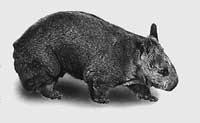Australian wombat marsupials in critical situation
The name of Wombat will be unknown to most. In Oceania, however, we can say that it is quite known. Currently, the situation of this marsupial mammal living in northern Australia is not good. Although the state of Queensland is the main habitat of the Wombat nose hairy, it is rare to find some specimen in this territory. According to the scientists' data, only three species of wombat nose hairs survive 65 specimens, all of them in the Epping National Park.

This unique mammal is sedentary, nocturnal and antisocial. Family of the bombatidos, with thick body and hairy and without tail. During the day he sleeps in a shelter and in the evening he goes out to eat grass. In winter it leaves the den in the early hours of the night and in summer it leaves at the last hours of the night to explore the food.
Andrew Woolnough and his team investigate the behaviors of this martsupial in the hope of saving the species. However, the wombat population is in a worrying crisis due to the destruction of natural habitat, droughts and the proliferation of competing animals.





